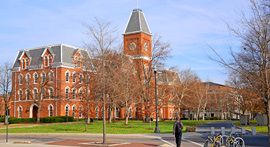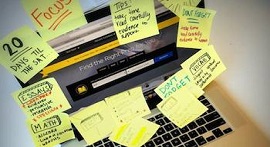Academics
Located in upstate New York, Skidmore College is a liberal arts school that places an emphasis on exploration and creative thought. Students assert that "the pursuit of knowledge is valued here," noting that you're encouraged to study "everything you are interested in," no matter how disparate the subjects seem. After all, the curriculum is designed to help undergraduates forge connections between different disciplines. Additionally, Skidmore students are privy to "small class sizes [that] allow for the formation of impactful and lasting relationships." Indeed, with a student-faculty ratio of 8:1 and an average class size of 16, it's easy to connect with your professors. It also helps that "teachers are accessible outside the classroom" and that the faculty tends to be "very helpful, understanding, and motivating." As one undergrad explains, the faculty "know we are human beings before we are students." Undergrads also appreciate that their education frequently extends beyond the walls of Skidmore's academic buildings. For example, there are "environmental studies [classes that] take place in the North Woods" and an artist interview class "in which each student chooses an artist they admire and [interviews] that artist." There's even a songwriting class that has students performing their compositions at Caffe Lena, the longest continually running folk music venue in the country. Perhaps this is why one undergrad confidently declares that Skidmore is "excellent when it comes to every path or field of study."
Student Body
Simply put, "Skidmore is the school for students who want to do it all." This sentiment rings true for many undergrads who report that their peers are "well-rounded and overaccomplished." Indeed, it's quite common to find students here have "at least a major and a minor [while juggling] involvement in multiple clubs, and probably working more than one job as well." Despite their busy schedules, these "active and involved" students always make time to be "super welcoming and friendly." They also tend to be left-leaning, with one undergrad noting that Skidmore undergrads "put the 'liberal' in liberal arts." Moreover, they embrace the diversity of the student body; more than a quarter of undergrads identify as a person of color and 3% are non-binary. Students also appreciate that there's a "drive for creativity," which seems to permeate the campus, and that everyone at Skidmore "has 'their people' and is welcome in many other circles and friend groups as well."
Campus Life
People at Skidmore are "constantly on the go," and incoming students can expect an undergraduate experience "full of activity and connection." Students share that their typical weekday includes "going to classes, eating meals with friends,...meeting for a group project, studying in the library, maybe [taking] a nap, and getting outdoors." A great way for students to socially connect is through the over 100 clubs and organizations offered, all of which make it easy for new students "to integrate and be a part of the community." Undergrads can participate in everything from Knit Wits (a group for knitting and crocheting enthusiasts) and Skidmore Quiz Bowl (a trivia team) to Pre-Law Club and the Skidmore Ice Hockey Club. Basically, you're guaranteed to find a group that'll pique your interest. The arts are especially popular here, and you'll find that "students are constantly collaborating and playing shows." This includes the school's six a cappella groups as well as Lively Lucy's Coffeehouse, a weekly open mic. For students looking to get off campus, they are just a ten-minute walk to downtown Saratoga Springs, "an amazing town." And for those looking to get a little farther away, the Adirondack Mountains and Lake George can be reached within an hour.




